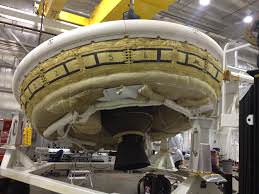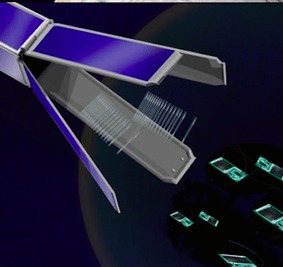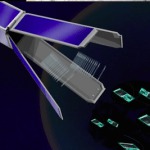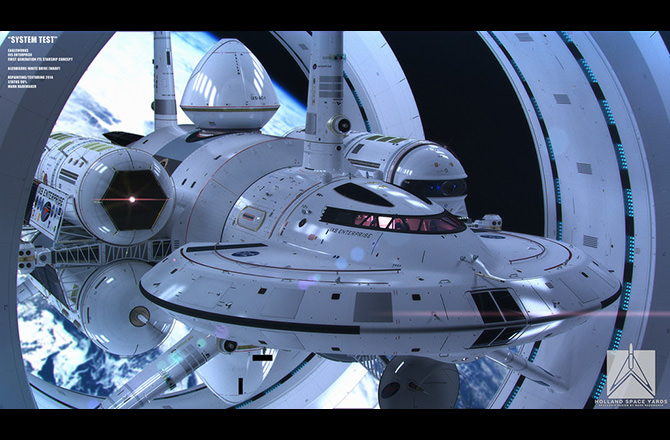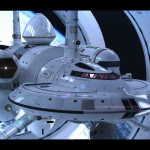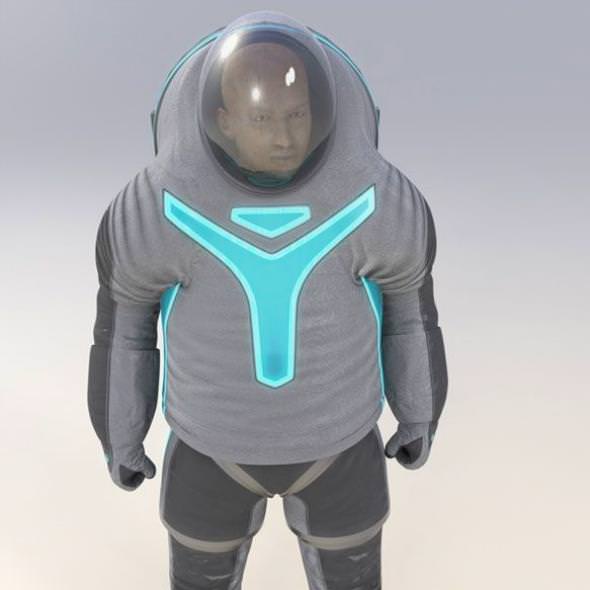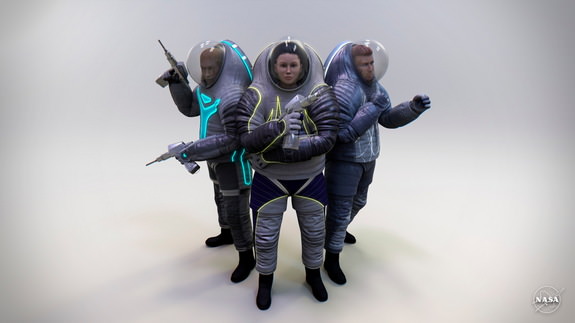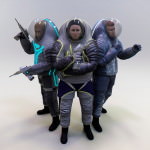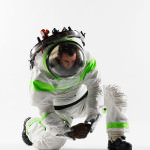Google smartphones in orbit
NASA announces that their Synchronized Position Hold, Engage, Reorient, Experimental Satellites (SPHERES) are being equipped with smartphones produced by Google which have a motion-tracking camera, infrared depth censors, and space-tested batteries equipped, allowing the satellites to navigate more easily:
We wanted to add communication, a camera, increase the processing capability, accelerometers and other sensors. As we were scratching our heads thinking about what to do, we realized the answer was in our hands. Let’s just use smartphones.
Saucer test run
0 CommentsNASA test runs a flyer saucer prototype that they will use to send to Mars. The saucer’s job is to land items and astronauts onto Mars. The agency partners with the U.S. Navy’s Kuaai location during the process. During the launch test, the winds were too disruptive as the helium balloon carried the saucer above the Pacific ocean. If the next test launch is not successful, the next flight won’t occur until next year. Investments of $150 million have already gone into the project and researchers are hopeful for a successful outcome.
Z-2 suit design
0 CommentsIn preparation for sending men to Mars, NASA designs a new prototype for a spacesuit. The company, ILC Dover will recreate Z-1 and Z-2 of the Z-series spacesuits, with emphasis on Z-2. The suit will be flexible in comparison to the bulky ones in current use. The flexibility will allow for easier walking, with adjustments that will help with easier leg movement and accurate foot placement. The wearer will enter the suit from the back and snap the upper and lower portions together at the waist. The Z-2 suit will be ready for testing in November. NASA hopes to make the trip to Mars in the mid 2030’s.
Satellite design
0 CommentsNASA is building a satellite that will explore moon oceans. The technology will be able to survey planets and also send instruments, unlike current technology that can either do one or the other. The first destination may be Jupiter’s moon, which researchers speculate holds water. The satellite, which will be the size of a milk cartoon, will be able to dispense fingernail-sized chips into the atmosphere to explore. When the chips are released, they float down to gather measurements, then send the information back to the mothership. NASA will partner with Draper Laboratories to design and prototype the satellite.
IXS Enterprise
0 CommentsNASA commissions for the design of a spaceship that can travel faster than light, or “warp drive.” The ship, named IXS Enterprise, resembles NASA’s current space shuttle and Star Trek’s Enterprise. Mark Rademaker, the ship’s visual designer, also designed the Star Trek ship. The spacecraft is however larger than his previous design. He says his influence is Matt Jeffrie’s sci-fi artworks from the 1960’s. NASA hopes that a breakthrough in Alcubierre drive technology will allow Rademaker’s concepts to become reality.
Z-2 design chosen
0 CommentsTechnology, the futuristic sci-fi inspired suit, wins the public’s vote as the next design. Of the 233,431 votes, 63% chose this option. The suit features Luminex wires and patches that illuminate. The light patches will allow for easier crew identification. The suit also features upgrades for flexibility and safety, with long missions in mind. The Delaware company, ILC Denver, will collaborate with students from Philadelphia University to create a prototype. The prototype will be ready by November 2014.
Spacesuit voting
0 CommentsNASA turns to the public to vote for the Z-2’s spacesuit design. The first option is called Biomimicry, which mimics the creatures found in Earth’s deepest oceans. The second option is called Technology, which has a futuristic look. The third option is called Trends In Society, which resembles clothing. All three suits contain strips of glowing light. NASA looks forward to using designs never used before. Voting ends in April.
Time Magazine best invention
0 Comments Time magazine lists NASA’s Z-1 spacesuit as one of the best inventions of the year. The suit, redesigned in silver, provides more flexible joints and radiation protections. The hatch on the back of the suit prevents dust from coming and and air from escaping.
Time magazine lists NASA’s Z-1 spacesuit as one of the best inventions of the year. The suit, redesigned in silver, provides more flexible joints and radiation protections. The hatch on the back of the suit prevents dust from coming and and air from escaping.
First tweet from space
Expedition 22 flight engineer T.J. Creamer posts the first unassisted tweet from the International Space Station. Before this point, all astronauts must email their tweets to Earth before they can be posted. The tweet is made possible by an upgrade that allows the International Space Station to access the World Wide Web.
Hello Twitterverse! We r now LIVE tweeting from the International Space Station — the 1st live tweet from Space! 🙂 More soon, send your ?s
— TJ Creamer (@Astro_TJ) January 22, 2010
A midnight plume
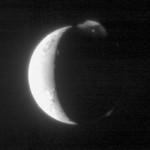 Another photo shows Io’s volcano Tvashtar erupting at the 1 o’clock position. The plume is about 330 km (200 miles) high and shows an asymmetrical and complicated wispy texture with incandenscent lava shown as the bright point of light. Another plume, likely from the volcano Masubi, is illuminated by Jupiter at the 5 o’clock position. A third and much fainter plume, barely visible at the 2 o’clock position, could be the first plume seen from the volcano Zal Patera.
Another photo shows Io’s volcano Tvashtar erupting at the 1 o’clock position. The plume is about 330 km (200 miles) high and shows an asymmetrical and complicated wispy texture with incandenscent lava shown as the bright point of light. Another plume, likely from the volcano Masubi, is illuminated by Jupiter at the 5 o’clock position. A third and much fainter plume, barely visible at the 2 o’clock position, could be the first plume seen from the volcano Zal Patera.
New Horizons and Io continue to astonish us with these unprecedented views of the solar system’s most geologically active body.
Jupiter’s rings
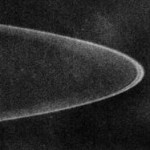 NASA releases a photo of Jupiter’s narrow ring measuring about 1,000 km (600 miles) wide with a fainter sheet of material inside it. A planetary astronomer suggests that the ring’s largest boulders are corralled into a narrow belt by the influence of Jupiter’s two innermost moons. The ring also appears to darken in the middle, a possible hint that a smaller, undiscovered moon is clearing out a gap. The faint glow extending in from the ring, the “halo,” is likely caused by fine dust that diffuses in toward Jupiter.
NASA releases a photo of Jupiter’s narrow ring measuring about 1,000 km (600 miles) wide with a fainter sheet of material inside it. A planetary astronomer suggests that the ring’s largest boulders are corralled into a narrow belt by the influence of Jupiter’s two innermost moons. The ring also appears to darken in the middle, a possible hint that a smaller, undiscovered moon is clearing out a gap. The faint glow extending in from the ring, the “halo,” is likely caused by fine dust that diffuses in toward Jupiter.
This is one of the clearest pictures ever taken of Jupiter’s faint ring system. The ring looks different from what we expected it has usually appeared much wider.
Jupiter gravity boost
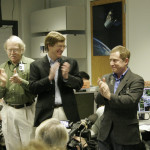 New Horizons makes its closest approach to Jupiter at a distance of 2.3 million km (1.4 million miles) passing through an aim point just 500 miles across in order to get a gravity assist that will boost its speed toward Pluto. The probe gains almost 14,000 km/h (9,000 mph) accelerating to over 83,600 km/h (52,000 mph). It has traveled 800 million km (500 million miles).
New Horizons makes its closest approach to Jupiter at a distance of 2.3 million km (1.4 million miles) passing through an aim point just 500 miles across in order to get a gravity assist that will boost its speed toward Pluto. The probe gains almost 14,000 km/h (9,000 mph) accelerating to over 83,600 km/h (52,000 mph). It has traveled 800 million km (500 million miles).
We’re on our way to Pluto. The swingby was a success; the spacecraft is on course and performed just as we expected.
Observes solar wind
New Horizons’ SWAP instrument sends back data on the solar wind around Jupiter. From a distance of 40 million miles, it observes an immense structure of compressed, dense, hot ionized gas that forms in the solar wind, called a co-rotating interaction region.
These solar wind structures collide with the magnetospheres of planets and, we believe, cause major variations in their structures. Because it has the largest magnetosphere in the solar system, the effects of the solar wind at Jupiter could have significant implications for all the planets.
Jupiter rendezvous
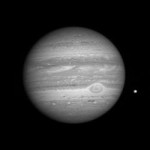 New Horizons rendezvous with Jupiter begins with black-and-white photos of Jupiter and infrared images of its moon Callisto. The probe is 81 million km (50 million miles) from the planet.
New Horizons rendezvous with Jupiter begins with black-and-white photos of Jupiter and infrared images of its moon Callisto. The probe is 81 million km (50 million miles) from the planet.
Our ground team has worked very hard to get to this point. Now the curtain is rising on the next stage of Jupiter-system exploration. It’s exciting!
Sees Pluto
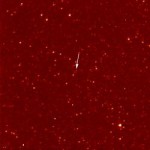 The Long Range Reconnaissance Imager (LORRI) takes its first photos of Pluto from 4.2 billion km (2.6 billion miles) away. At this distance Pluto is just a faint point of light among the stars.
The Long Range Reconnaissance Imager (LORRI) takes its first photos of Pluto from 4.2 billion km (2.6 billion miles) away. At this distance Pluto is just a faint point of light among the stars.
Finding Pluto in this dense star field really was like trying to find a needle in a haystack. LORRI passed this test with flying colors, because Pluto’s signal was clearly detected at 30 to 40 times the noise level in the images.
Jupiter images
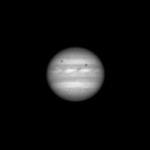 New Horizons probe takes its first pictures of Jupiter with its Long Range Reconnaissance Imager (LORRI) from 291 million km (181 million miles) away.
New Horizons probe takes its first pictures of Jupiter with its Long Range Reconnaissance Imager (LORRI) from 291 million km (181 million miles) away.
LORRI’s first Jupiter image is all we could have expected. We see belts, zones and large storms in Jupiter’s atmosphere. We see the Jovian moons Io and Europa, as well as the shadows they cast on Jupiter. It is most gratifying to detect these moons against the glare from Jupiter.
Tracks asteroid
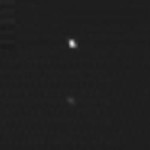 In order to test its tracking and imaging capabilities, the probe tracks and photographs asteroid 2002 JF56 in the asteroid belt coming to within 102,000 km. The asteroid is about 2.5 km in diameter.
In order to test its tracking and imaging capabilities, the probe tracks and photographs asteroid 2002 JF56 in the asteroid belt coming to within 102,000 km. The asteroid is about 2.5 km in diameter.
The asteroid observation was a flight test, a chance for us to test the spacecraft’s ability to track a rapidly moving object and to refine our sequencing process. The objects we will observe this winter in the Jupiter system will appear to be moving across the sky much more slowly than this asteroid, so these observations were an unexpected opportunity to prepare for the even faster tracking rates we’ll experience in summer 2015, when the spacecraft zips through the Pluto system at more than 31,000 miles per hour.
The probe is now 283 million km (176 million miles) from Earth traveling at 27 km (17 miles) per second relative to the sun.
Crosses Mars’ orbit
 The probe passes Mars’ orbit. It is now 93.5 million km (58.1 million miles) from Earth traveling at 21 km (13 miles) per second relative to the sun.
The probe passes Mars’ orbit. It is now 93.5 million km (58.1 million miles) from Earth traveling at 21 km (13 miles) per second relative to the sun.
Payload passes tests
Space controllers have tested science instruments on board and confirm that all instruments survived the launch and are working properly.
The instruments are sending back a lot of housekeeping data that says they’re working the way they’re supposed to. The mission science team is just beaming to know that the entire payload survived the stresses of launch in good health.
Third course correction
The probe fires its thrusters again for 76 seconds in order to perfect its path toward Jupiter. It is 51.7 million km (32.1 million miles) from Earth traveling at 37.5 km (23.3 miles) per second.

